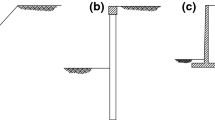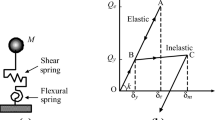Abstract
The earthquake forces used in design codes of buildings should be theoretical determinable. This work examines the seismic force modification factorR based on elastic-plastic time-history earthquake analysis of SDOF systems, wherein the hysteresis models are elastic-perfectly-plastic (EPP), elastic-linearly-hardening (ELH), shear-slipped and bilinear-elastic. The latter two models are analysed for separating the effect of the ductility and the energy-dissipating capacity. Three-hundred eighty-eight earthquake records from different site conditions are used in analysis. The ductility is taken to be 2, 3, 4, 5 and 6, with the damping ratio being 0.02, 0.035 and 0.05 respectively. The post-yield stiffness ratios 0.0, 0.1 and 0.2 are used in the analysis. TheR spectra are standardized by the characteristic period of the earthquake records, which leads to a much smaller scatter in averaged numerical results. It was found that the most important factor determiningR is the ductility.R increases more than linearly with ductility. The energy-dissipating capacity, damping and the post-yield stiffness are the less important factors. The energy dissipating capacity is important only for structures with short period and moderate period (0.3≤T/T g <5.0). For EPP and ELH models,R for 0.05 damping is 10% to 15% smaller than for 0.02 damping. For EPP and ELH models, greater post-yield stiffness leads to greaterR, but the influence of post-yield stiffness is obvious only when the post-yield stiffness is less than 10% of the initial stiffness. By means of statistical regression analysis the relation of the seismic force modification factorR with the natural period of the system and ductility for EPP and ELH models were established for each site and soil condition.
Similar content being viewed by others
References
Borzi, B., Elnashai, A.S., 2000. Refined force reduction factors for seismic design.Engineering Structures,22:1244–1260.
Fajfar, P., 1995. The 10th European Conf. on Earthquake Engineering, Balkema, p.2969–2974.
Huang, J.Q., 2005. Elastic-plastic Dynamics and Aseismic Design Theory of Steel Structures. Ph.D Thesis, Zhejiang University, p.103–147 (in Chinese).
Kappos, A.J., 1999. Evaluation of behavior factors on the basis of ductility and overstrength studies.Engineering Structures,21:823–835.
Krawinkler, H., Nassar, A.A., 1992. Seismic Design Based on Ductility and Cumulative Damage Demand and Capacities.In: Fajfar, K. (Ed.), Nonlinear Seismic Analysis and Design of Reinforced Concrete Buildings. Elsevier Applied Science, New York.
Li, H.L., Sang, W.H., Young, H.O., 1999. Determination of ductility factor considering different hysteretic models.Earthquake Engineering and Structural Dynamics,28:957–977.
Miranda, E., 1993. Site-dependent strength-reduction factors.Journal of Structural Engineering,119:3503–3519.
Miranda, E., Bertero, V.V., 1994. Evaluation of strength reduction factor for earthquake-resistance design.Earthquake Spectra,10(3):357–379.
Newmark, N.M., Hall, W.J., 1982. Earthquake Spectra and Design. EERI Monograph Series, Oakland.
Vidic, T., Fajfar, P., Fischinger, M., 1994. Consistent inelastic design spectra: strength and displacement.Earthquake Engineering and Structural Dynamics,23:507–521.
Xu, Z.X., Yu, A.D., 1998. Discuss about seismic influence coefficient.Engineering Mechanics Supplement, p.100–107 (in Chinese).
Zhuo, W.D., Fan, L.C., 2001. On strength reduction factors used for seismic design of structures.Earthquake Engineering and Engineering Vibration,21(1):84–88 (in Chinese).
Author information
Authors and Affiliations
Corresponding author
Rights and permissions
About this article
Cite this article
Tong, Gs., Jin-qiao, H. Seismic force modification factor for ductile structures. J. Zheijang Univ.-Sci. A 6, 813–825 (2005). https://doi.org/10.1631/jzus.2005.A0813
Received:
Accepted:
Published:
Issue Date:
DOI: https://doi.org/10.1631/jzus.2005.A0813




